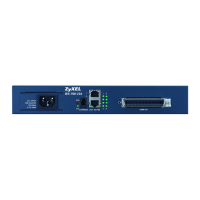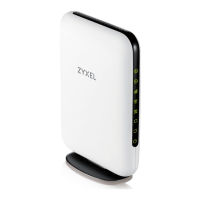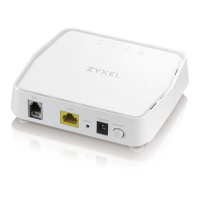Chapter 7 Interfaces
USG FLEX H Series User’s Guide
129
7.6 Trunk Overview
Use trunks for WAN traffic load balancing to increase overall network throughput and reliability. Load
balancing divides traffic loads between multiple interfaces. This allows you to improve quality of service
and maximize bandwidth utilization for multiple ISP links.
Maybe you have two Internet connections with different bandwidths. You could set up a trunk that uses
weighted round robin load balancing so time-sensitive traffic (like video) usually goes through the
higher-bandwidth interface. For other traffic, you might want to use least load first load balancing to
even out the distribution of the traffic load.
Suppose ISP A has better connections to Europe while ISP B has better connections to Australia. You
could use policy routes and trunks to have traffic for your European branch office primarily use ISP A and
traffic for your Australian branch office primarily use ISP B.
Or maybe one of the Zyxel Device's interfaces is connected to an ISP that is also your Voice over IP
(VoIP) service provider. You can use policy routing to send the VoIP traffic through a trunk with the
interface connected to the VoIP service provider set to active and another interface (connected to
another ISP) set to passive. This way VoIP traffic goes through the interface connected to the VoIP
service provider whenever the interface’s connection is up.
• Use the Trunk summary screen (Section 7.7 on page 131) to view the list of configured trunks and
which load balancing algorithm each trunk uses.
• Use the Add Trunk screen (Section 7.7.1 on page 133) to configure the member interfaces for a trunk
and the load balancing algorithm the trunk uses.
Check Method Select the method that the gateway allows.
Select icmp to have the Zyxel Device regularly ping the gateway you specify to make sure
it is still available.
Select tcp to have the Zyxel Device regularly perform a TCP handshake with the gateway
you specify to make sure it is still available.
Check Period Enter the number of seconds between connection check attempts.
Check Timeout Enter the number of seconds to wait for a response before the attempt is a failure.
Check Fail
Tolerance
Enter the number of consecutive failures before the Zyxel Device stops routing through the
gateway.
Check These
Addresses
Specify one or two domain names or IP addresses for the connectivity check.
You can type an IPv4 address in one field and a domain name in the other. For example,
type “192.168.1.2” in the top filed and “www.zyxel.com” in the bottom field.
Check Succeeds
When
This field applies when you specify two domain names or IP addresses for the connectivity
check.
Select Any if you want the check to pass if at least one of the domain names or IP
addresses responds.
Select All if you want the check to pass only if both domain names or IP addresses respond.
OK Click OK to save your changes back to the Zyxel Device.
Cancel Click Cancel to exit this screen without saving.
Table 68 Network > Interface > > Interface > VTI > Add/Edit (continued)
LABEL DESCRIPTION

